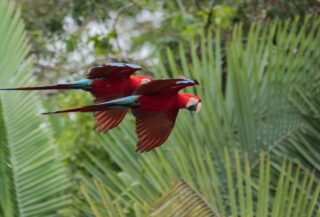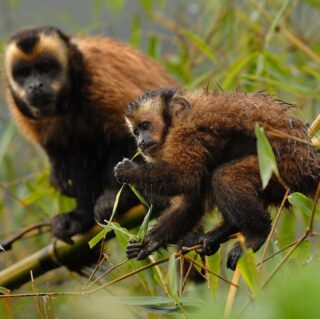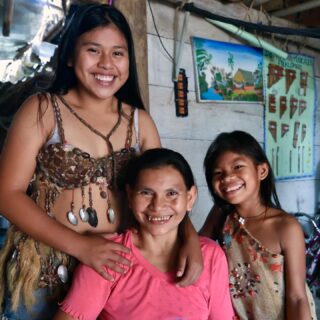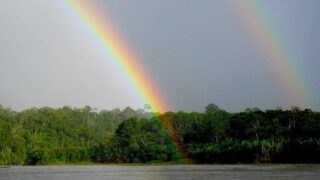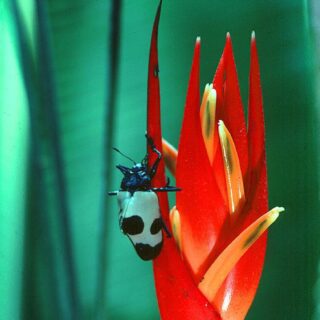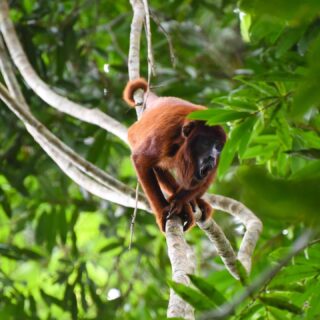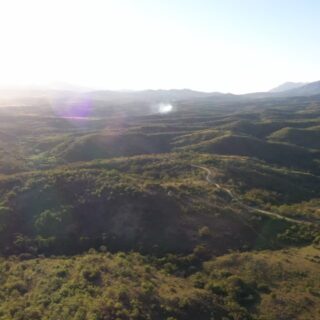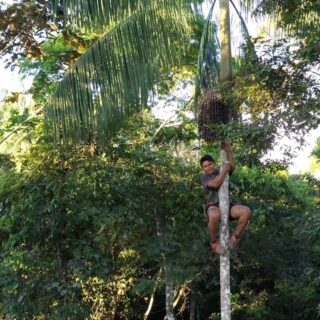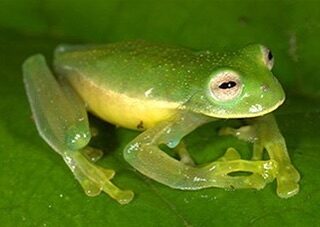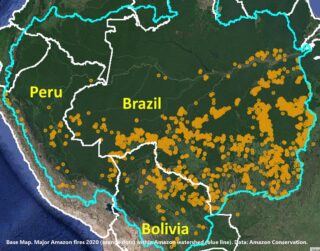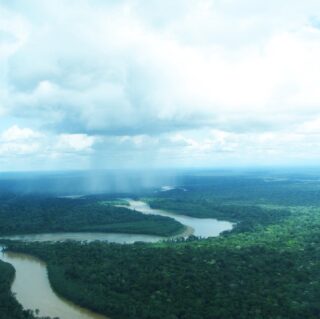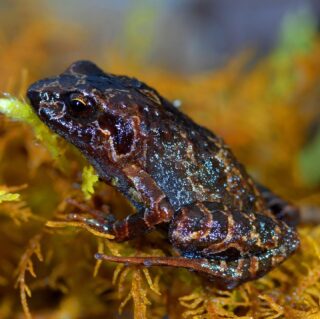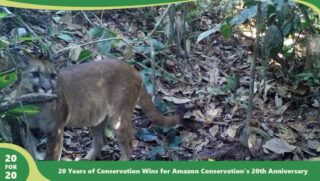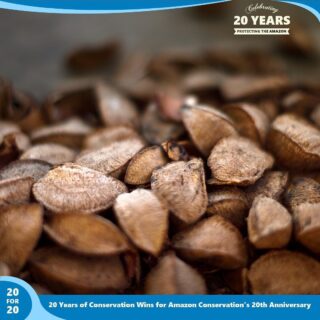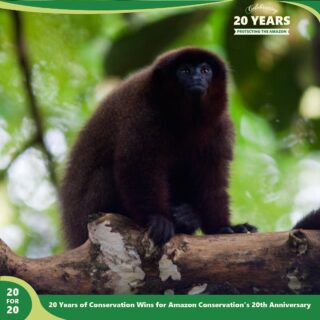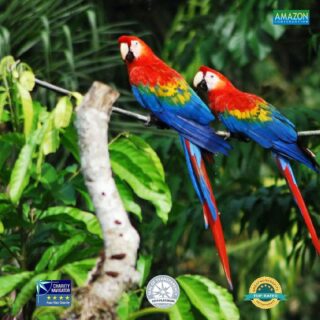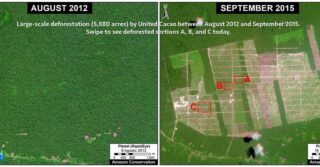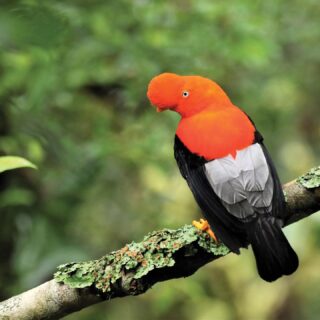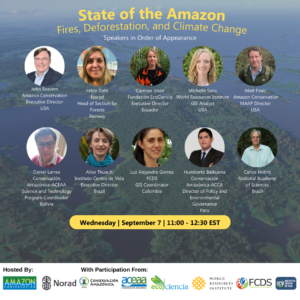 Wednesday, September 7th, saw the first installment of our State of the Amazon Webinar Series. This edition’s focus was on Fires, Deforestation, and Climate Change. The webinar was co-hosted by us and the Norwegian Agency for Development Cooperation (Norad) and featured speakers from five of our partners representing five key Amazonian countries. Participants had the privilege of hearing from Fundación EcoCiencia (Ecuador), Instituto Centro de Vida (Brazil), Conservación Amazónica – ACCA (Peru), Conservación Amazónica – ACEAA (Bolivia), Fundación para la Conservación y al Desarrollo Sostenible (Colombia), and MAAP and Global Forest Watch from the US. The broad scope of our panelists and partners allowed us to offer a vast perspective on the threats of fires, deforestation, and climate change and their relation to forest loss from a global scale, down to a focused “on-the-ground” perspective of the effects of those same threats in the 5 different countries represented therein. Apart from their country-specific experiences with environmental threats to the Amazon, each presenter spoke about how fires, deforestation, and climate change are interrelated and work together to create challenging hurdles to achieve a thriving Amazon. Watch the full webinar recording here.
Wednesday, September 7th, saw the first installment of our State of the Amazon Webinar Series. This edition’s focus was on Fires, Deforestation, and Climate Change. The webinar was co-hosted by us and the Norwegian Agency for Development Cooperation (Norad) and featured speakers from five of our partners representing five key Amazonian countries. Participants had the privilege of hearing from Fundación EcoCiencia (Ecuador), Instituto Centro de Vida (Brazil), Conservación Amazónica – ACCA (Peru), Conservación Amazónica – ACEAA (Bolivia), Fundación para la Conservación y al Desarrollo Sostenible (Colombia), and MAAP and Global Forest Watch from the US. The broad scope of our panelists and partners allowed us to offer a vast perspective on the threats of fires, deforestation, and climate change and their relation to forest loss from a global scale, down to a focused “on-the-ground” perspective of the effects of those same threats in the 5 different countries represented therein. Apart from their country-specific experiences with environmental threats to the Amazon, each presenter spoke about how fires, deforestation, and climate change are interrelated and work together to create challenging hurdles to achieve a thriving Amazon. Watch the full webinar recording here.
Hilde Dahl, Head of Section for Forests with Norad, opened the session by expressing the urgency with which the environment must be addressed, stating, “Without halting deforestation and bolstering reforestation with urgent action it will be impossible to meet the UN sustainable development goals and the goals of the Paris Agreement.” She also laid out some of the methods and objectives that the Norwegian government has committed to foster in order to address these concerns, including direct support for organizations and initiatives that are heading programs and processes to bolster the well-being of the Amazon with the over-arching goal of Norad being to prevent widespread tropical forest loss. Hilde added finally, “The Amazon is undoubtedly important for the health of our climate, but it is also simply home to millions of people.”
Carmen Josse from EcoCiencia moderated the discussion and opened by introducing the the two scientists presenting in the first section of the webinar – two wide perspectives of forest loss. First, a global perspective from Michelle Sims from Global Forest Watch and World Resources Institute.
Understanding Trends in Global Forest Loss
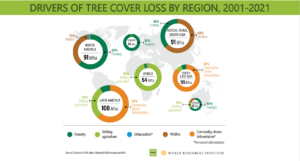 Our first presenter, Michelle Sims, from Global Forest Watch at World Resources Institute, presented a global overview on forest loss. She described what the data is telling us are the actual main drivers of forest loss today. She also presented where the most forest loss is happening by country, stating that Bolivia has overtaken Indonesia for third place for country experiencing most forest loss for the second year in a row. Interestingly, Michelle reports that commodities production, sourcing wood from tropical forests for manufacturing or clearing large swaths of forest for cattle raising, was also a significant driver of forest loss around the world in 2021.
Our first presenter, Michelle Sims, from Global Forest Watch at World Resources Institute, presented a global overview on forest loss. She described what the data is telling us are the actual main drivers of forest loss today. She also presented where the most forest loss is happening by country, stating that Bolivia has overtaken Indonesia for third place for country experiencing most forest loss for the second year in a row. Interestingly, Michelle reports that commodities production, sourcing wood from tropical forests for manufacturing or clearing large swaths of forest for cattle raising, was also a significant driver of forest loss around the world in 2021.
Zooming in to a regional view of the Amazon as a whole, Amazon Conservation’s own Matt Finer, Director of the Monitoring of the Amazon Project, presented his latest findings using satellite imagery to pinpoint deforestation drivers and shared some thought provoking data. Dr. Finer clearly illustrated how fires, deforestation, and climate change only work to feed each other. These three environmental phenomena are often studied individually or separately, however, it is becoming more and more evident that deforestation brings about more fires and fires bring about more deforestation and both affect the climate and are a result of the changing climate, an interesting and powerfully dangerous relationship indeed. 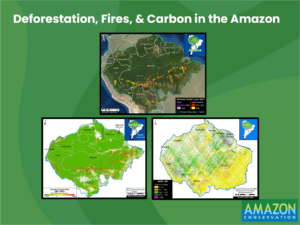
Implications for the Amazon (Bolivia)
We heard our first country-specific perspective from Daniel Larrea, Science and Technology Program Coordinator from Conservación Amazónica – ACEAA. Daniel shared that one of the strongest drivers of deforestation in the Bolivian lowlands of the Amazon is forest clearing for cattle raising, a fact echoed by Michelle Sims’s global studies. Daniel reported that what the science is showing in Bolivia as a result of increased cattle production and decreased natural forest cover is an increase in CO2 levels and an increase in high temperature changes in the region’s climate. Daniel ended with a powerful quote summing up the goals of his and ACEAA’s work saying, “If we protect our forest they will be healthy. If our forest are healthy, they will be productive. If they are healthy and productive, they will be resilient.”
Science and Data for Advocacy and Action (Brazil)
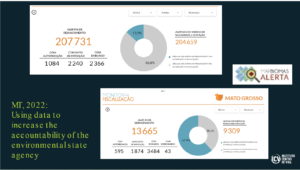 Alice Thuault, the Executive Director of Instituto Centro de Vida (ICV), then explained that the future of the Amazon depends scientists and advocacy groups to use the data these new technologies are showing us to reinforce each others’ efforts and best protect the forest. She pointed out that the Amazon is a vast region, one that spans at least 9 countries, that requires strong coordination and action from multiple entities to ensure its protection. Luckily, we have organizations like ICV and the rest that presented at this webinar who are actively heading this union of scientific data and advocacy work to better inform conservation efforts throughout the entire Amazon forest.
Alice Thuault, the Executive Director of Instituto Centro de Vida (ICV), then explained that the future of the Amazon depends scientists and advocacy groups to use the data these new technologies are showing us to reinforce each others’ efforts and best protect the forest. She pointed out that the Amazon is a vast region, one that spans at least 9 countries, that requires strong coordination and action from multiple entities to ensure its protection. Luckily, we have organizations like ICV and the rest that presented at this webinar who are actively heading this union of scientific data and advocacy work to better inform conservation efforts throughout the entire Amazon forest.
Understanding the Arc of Deforestation and Road Construction (Colombia)
Luz Alejandra Gomez, GIS Coordinator with Fundación para la Conservación y el Desarrollo Sostenible (FCDS), presented some of her recent work with high-resolution satellite imagery that helped us all to better understand the trends of deforestation in Colombia specifically caused by the construction of new roads. If you have kept up with any of our MAAP reports, you already know that carving out new roads or even maintaining pre-existing roads is a significant driver of deforestation in the Amazon. Accordingly, Luz Alejandra’s findings show a slight uptick of deforestation caused by road construction from 2019 up to the present, especially surrounding legally protected national parks and reserves. She also offered a stark reminder that the current main objective of these roads is to provide access and link to similarly illegal and unregulated farming and other sites of extractive activities. 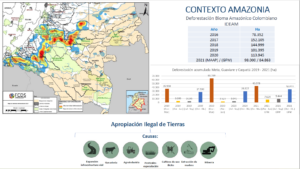
Composition and Threats (Ecuador)
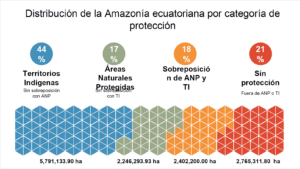
Attendees then heard from Carmen Josse, Executive Director of Fundación EcoCiencia. Carmen presented an informative look at the composition of the Ecuadorian Amazon regarding land use and classification. 44% of the Ecuadorian Amazon is dedicated Indigenous Territory, 18% is both Indigenous Territory and Natural Protected Area, 17% is Natural Protected Area only, and 21% is without any protection whatsoever. Over all of these combined areas, we see from EcoCiencia’s data that up to at least 14% of the Ecuadorian Amazon is experiencing deforestation due to agricultural activities, authorized or otherwise. Carmen reports that since 2001, EcoCiencia has confirmed 623,151 hectares of deforestation and areas dedicated to extractive mining activities have tripled since as recent as 2010.
Strengthening Environmental Governance (Peru)
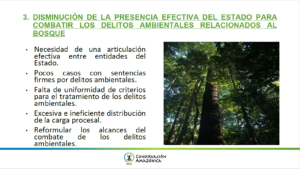
For our last country-specific presentation, Humberto Balbuena, Director of Policy and Environmental Governance at Conservación Amazónica – ACCA, offered a look at important conservation and governance efforts in Peru. Humberto identified a few main hurdles to conservation faced by governance objectives. 1) Increase in agricultural activity in forested areas that have potential for greater sustainably productive practices. 2) Expansion of illegal mining activities. 3) A decrease in state presence to effectively combat environmental crimes. 4) Delays in the process of institutionality in the forest sector. Humberto highlights these obstacles as a reminder that the fight to protect the Amazon has to be won not only on-the-ground in the forest, but also within policy and legal frameworks. By using monitoring systems and near real time reports, policy makers and legal actors are better equipped to take justified and informed stands against illegal activity in the Amazon.
Q & A
Carmen Josse moderated our Q & A session in which attendees could pose questions to each or all of the speakers. One question pur to Dr. Matt Finer was, “What is the impact of Indigenous Territories and Protected Areas on fires and deforestation?” To which he responded and showed on maaproject.org, “…pretty remarkably we can clearly see that the best protections against the Amazon continue to be Indigenous Territories and Protected Areas. You can almost draw a map of these two classifications based on where the fires are not.”
Closing Remarks
Carlos Nobre provided some profound statements on the urgency of protecting the Amazon when issuing his closing remarks, especially, “We know very well that the Amazon is near its tipping point. Fires, deforestation and climate change are synergistic obstacles which make each other more difficult to combat. The saving grace of the Amazon is its incredible ability to recycle water throughout its ecosystems. Without urgent action, this land use change that we are seeing become the trend, could take away that ability from the Amazon and see it turned into what would be more closely related to a dry savannah.”
To view the full question and answer session and watch the entire presentation, click here.

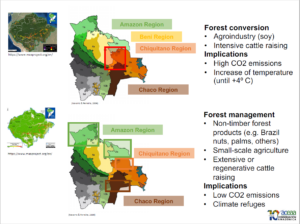
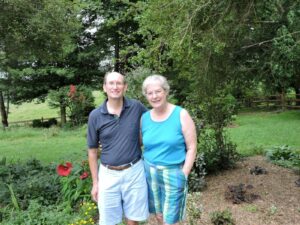
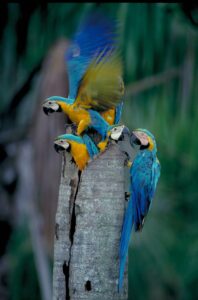 Elizabeth: You also mentioned, which I also remember from Mr. [Bruce] Babbitt’s talk about 8 or 10 years ago, how well you work with companies so that they can do business and find ways to do it without destroying everything.
Elizabeth: You also mentioned, which I also remember from Mr. [Bruce] Babbitt’s talk about 8 or 10 years ago, how well you work with companies so that they can do business and find ways to do it without destroying everything.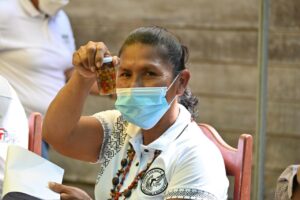 Over the past month, Amazon Conservation inaugurated two new critical facilities that mark important milestones for our conservation efforts in Peru. The first is a new processing plant, which is fundamental in our
Over the past month, Amazon Conservation inaugurated two new critical facilities that mark important milestones for our conservation efforts in Peru. The first is a new processing plant, which is fundamental in our 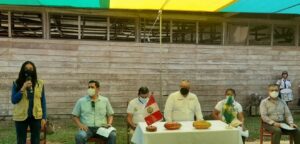 The creation of this processing facility is the result of a public-private effort between private companies, regional governments, and local communities to ensure the preservation of the artisanal quality of cacao and copoazu (a tropical fruit also known as “white chocolate”). At the inauguration, María Elena Gutiérrez, Executive Director of Conservación Amazónica–ACCA, announced, “This is a day of celebration for the people of the Native Community of Infierno, with whom we have been working for many years, and represents a huge step in their ability to make a living from native cacao and copoazu, not only in national but also international markets. At Amazon Conservation, we believe that sustainable livelihoods are vital so that people can live with a healthy and resilient Amazon.”
The creation of this processing facility is the result of a public-private effort between private companies, regional governments, and local communities to ensure the preservation of the artisanal quality of cacao and copoazu (a tropical fruit also known as “white chocolate”). At the inauguration, María Elena Gutiérrez, Executive Director of Conservación Amazónica–ACCA, announced, “This is a day of celebration for the people of the Native Community of Infierno, with whom we have been working for many years, and represents a huge step in their ability to make a living from native cacao and copoazu, not only in national but also international markets. At Amazon Conservation, we believe that sustainable livelihoods are vital so that people can live with a healthy and resilient Amazon.”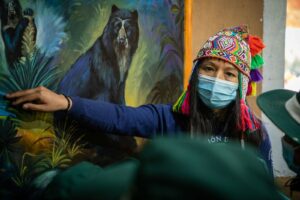 On July 1, a new Andean Bear Interpretation Center was inaugurated in our Wayqecha Conservation Hub in Peru’s department of Cusco. Located in a cloud forest in the buffer zone of Peru’s Manu National Park, this area is critical for conservation efforts thanks to its high biodiversity and endemic species and its position as a natural corridor for plant and animal species pushed uphill by global warming, making it an ideal location to connect national and international visitors with nature and science.
On July 1, a new Andean Bear Interpretation Center was inaugurated in our Wayqecha Conservation Hub in Peru’s department of Cusco. Located in a cloud forest in the buffer zone of Peru’s Manu National Park, this area is critical for conservation efforts thanks to its high biodiversity and endemic species and its position as a natural corridor for plant and animal species pushed uphill by global warming, making it an ideal location to connect national and international visitors with nature and science.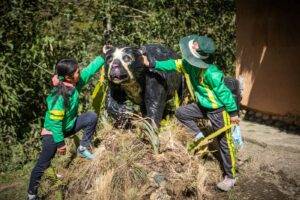 The Andean Bear Interpretation Center is an important space for environmental education for local students and our science team at our sister organization Conservación Amazónica – ACCA in Peru as we work to better understand the behavior of the Andean bear, also known as the spectacled bear. A threatened species and the only bear in South America, the Andean bear is a keystone species in this region of Peru, currently under threat by habitat loss, forest fires, hunting, and animal trafficking. Since their territory covers long distances, they also play a critical ecological role in dispersing seeds across high elevations and thus regenerating forests.
The Andean Bear Interpretation Center is an important space for environmental education for local students and our science team at our sister organization Conservación Amazónica – ACCA in Peru as we work to better understand the behavior of the Andean bear, also known as the spectacled bear. A threatened species and the only bear in South America, the Andean bear is a keystone species in this region of Peru, currently under threat by habitat loss, forest fires, hunting, and animal trafficking. Since their territory covers long distances, they also play a critical ecological role in dispersing seeds across high elevations and thus regenerating forests.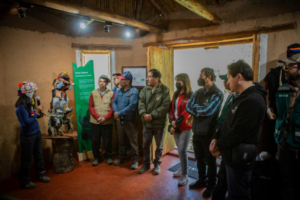 Amazon Conservation’s Andean Bear Conservation Program, led by Ruthmery Pillco, has been working to protect their habitats and restore the plants that are part of their diet through conservation efforts alongside local populations, for whom the Andean bear is a cultural icon. Through citizen science, community-based reforestation, and environmental education efforts, we hope to restore the habitat necessary for this species’ survival and raise awareness about the vulnerability of cloud forest ecosystems in the face of climate change.
Amazon Conservation’s Andean Bear Conservation Program, led by Ruthmery Pillco, has been working to protect their habitats and restore the plants that are part of their diet through conservation efforts alongside local populations, for whom the Andean bear is a cultural icon. Through citizen science, community-based reforestation, and environmental education efforts, we hope to restore the habitat necessary for this species’ survival and raise awareness about the vulnerability of cloud forest ecosystems in the face of climate change.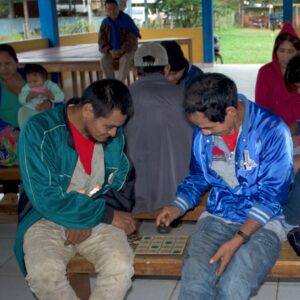 In the Bolivian department of Pando, Amazon Conservation through our sister organization Conservación Amazónica–ACEAA held workshops in the communities of Holanda, Empresiña, San Antonio, and Luz de América to spread awareness about the impacts of human activities on the Amazon rainforest. These workshops, part of the PRODIGY project financed by the German Ministry of Research and Education-BMBF, included interactive learning activities and games that informed participants from these local communities about the chemical makeup of the Amazon ecosystem and helped demonstrate how human activities can alter the ecosystem’s vulnerable chemistry.
In the Bolivian department of Pando, Amazon Conservation through our sister organization Conservación Amazónica–ACEAA held workshops in the communities of Holanda, Empresiña, San Antonio, and Luz de América to spread awareness about the impacts of human activities on the Amazon rainforest. These workshops, part of the PRODIGY project financed by the German Ministry of Research and Education-BMBF, included interactive learning activities and games that informed participants from these local communities about the chemical makeup of the Amazon ecosystem and helped demonstrate how human activities can alter the ecosystem’s vulnerable chemistry.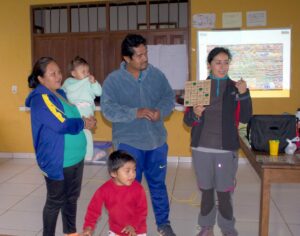 One exercise explored how uncontrolled extractive activities such as illegal gold mining can leave behind harmful substances like mercury that enter and disrupt the natural chemistry of the Amazon as a result of agitating river sediment and destroying river banks.
One exercise explored how uncontrolled extractive activities such as illegal gold mining can leave behind harmful substances like mercury that enter and disrupt the natural chemistry of the Amazon as a result of agitating river sediment and destroying river banks.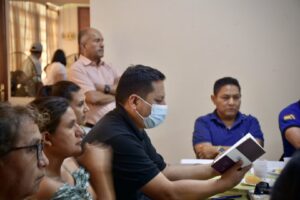 On June 28, at a meeting of the Inter-Institutional Platform for Connection of Amazon Fruit Products (PICFA) in Cobija, Bolivia, we presented a study that corrects misinformation about the link between açai and the parasite causing Chagas disease in the region. While the parasite Trypanosoma cruzi has been found in the primary açai species produced in Brazil (Euterpe olerásea), the açai species grown in Pando (Euterpe precatoria) is distinct. The presentation of this research, which impacts açai producers across the region, shows the importance of disseminating information through the
On June 28, at a meeting of the Inter-Institutional Platform for Connection of Amazon Fruit Products (PICFA) in Cobija, Bolivia, we presented a study that corrects misinformation about the link between açai and the parasite causing Chagas disease in the region. While the parasite Trypanosoma cruzi has been found in the primary açai species produced in Brazil (Euterpe olerásea), the açai species grown in Pando (Euterpe precatoria) is distinct. The presentation of this research, which impacts açai producers across the region, shows the importance of disseminating information through the 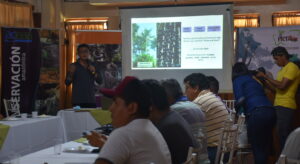 this study also serves as an important tool for early detection measures to control and prevent the spread of diseases like Chagas in the processing of Amazonian fruits in Pando.
this study also serves as an important tool for early detection measures to control and prevent the spread of diseases like Chagas in the processing of Amazonian fruits in Pando.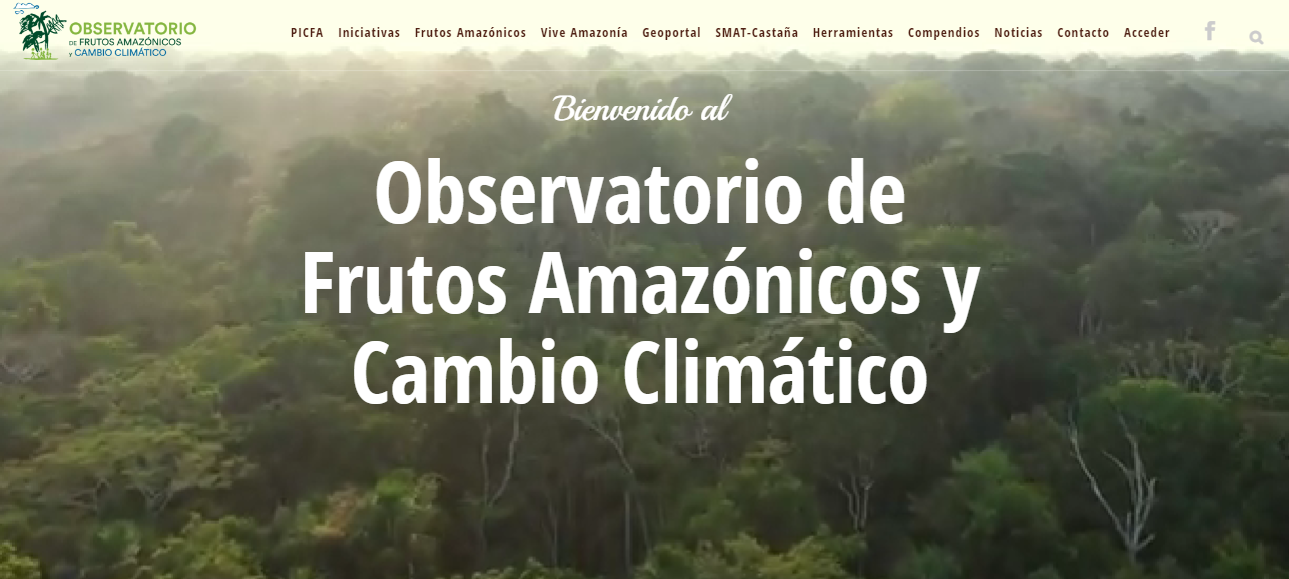

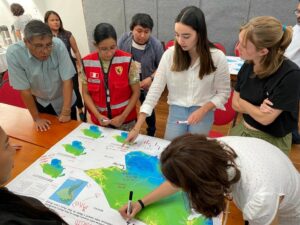
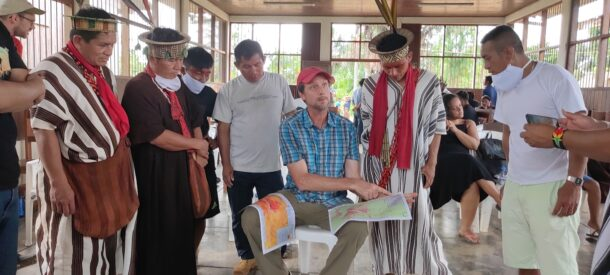
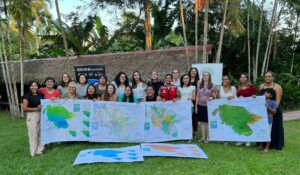
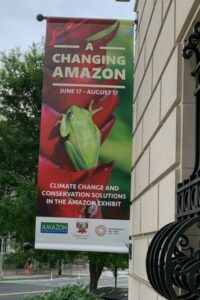 On Thursday, June 16, Amazon Conservation inaugurated our gallery exhibit “A Changing Amazon: Climate Change and Conservation Solutions in the Amazon” at the Embassy of Peru in Washington, DC. The gallery exhibit, now open to the public through August 17, gives a visual retrospection of our work in Peru, explains how climate is affecting the Amazon, the role of Indigenous peoples in conservation, and showcases our conservation solutions in the region.
On Thursday, June 16, Amazon Conservation inaugurated our gallery exhibit “A Changing Amazon: Climate Change and Conservation Solutions in the Amazon” at the Embassy of Peru in Washington, DC. The gallery exhibit, now open to the public through August 17, gives a visual retrospection of our work in Peru, explains how climate is affecting the Amazon, the role of Indigenous peoples in conservation, and showcases our conservation solutions in the region.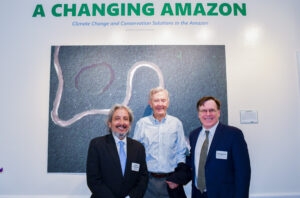 The highlight of the evening were the special remarks from the Peruvian Embassy, Bruce Babbitt, the former Governor of Arizona and former Secretary of the Interior; and Manuel Pulgar-Vidal, President of the COP 20 UN Climate Convention, former Peruvian Minister of the Environment, current Leader of the Climate and Energy Global Practice of World Wild Fund for Nature International, and recently-appointed Chair of IUCN’s newly established Climate Crisis Commission.
The highlight of the evening were the special remarks from the Peruvian Embassy, Bruce Babbitt, the former Governor of Arizona and former Secretary of the Interior; and Manuel Pulgar-Vidal, President of the COP 20 UN Climate Convention, former Peruvian Minister of the Environment, current Leader of the Climate and Energy Global Practice of World Wild Fund for Nature International, and recently-appointed Chair of IUCN’s newly established Climate Crisis Commission.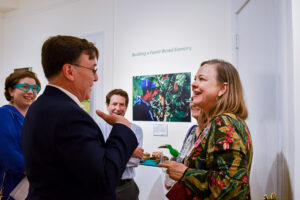

